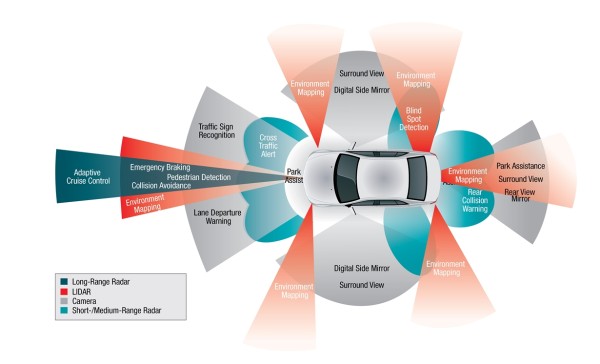Astonishing Advances that May Eliminate Accidents — and Put Valets Out of Business
Sci-fi writers and futurists have been dreaming up driverless cars for decades, but now we’re on the brink of making the stuff of fiction, and Hollywood movies, a reality. Innovations in sensor technology, processing capabilities, and lower power and alternative energy will converge rapidly over the next twenty years to transform the way we commute, travel, and ultimately how we live.
As a research engineer at Texas Instruments, I work to develop the hardware that will make autonomous vehicles a reality. The technology is impressive to me for a number of reasons – while safety is a primary motivator, the changes that will result also help us rethink our commutes, enable access to transportation to those who may not have it today, and ultimately improve our lives for the better in a myriad of ways. The advances detailed below will allow drivers to associate the concept of serenity and calm with driving; in fact, it’s not too much of a stretch to imagine that “road rage” may become a thing of the past.
In this article, an extension of my “Under the Hood” talk at SXSW 2015, I explain some of the hardware that researchers all over the world are reviewing to make self-driving cars a reality, and also my own opinions about what exciting implications these technologies will bring.
How Your Car Will Become a Smart, Relaxing De Facto Taxi
Over the next few decades, auto-makers will gradually adopt sensor systems to improve safety. Even today, camera systems and short-range radar, providing features like lane-drift detection, autonomous braking, collision avoidance, and side-view assist are common features. From that beginning, new technologies that leverage both features, such as automatic parallel parking assist, are becoming available.
In the next wave of adoption, the addition of compact, low-cost LIDAR (Light Detection and Ranging) systems will enable the vehicle to drive mostly autonomously, with (amazingly!) the need for driver input only in emergencies and special circumstances such as heavy traffic or construction. LIDAR systems enable the car to use dozens of lasers to accumulate over a million data points about its immediate environment every second, so in full autonomy, the vehicle will simply require an input destination, and the sensors and computers will take it from there.
In my talk at SXSW, I showed how researchers are developing hardware technologies that will enable myriad sensors to be in any auto (see figure below) and also to efficiently process data so that the car can make driving decisions quickly.

Safety First: Your Car as a Good Buddy, Looking Out for You
It should be said at this point that USA TODAY found in a 2013 poll that many people name their cars, as if they are a friend, and the science of the future may well show that they are not far off in that sentimental attachment. Here’s why:
-
-
- Relatively simple features already available today include lane detection, which can wake a sleepy driver when she starts to drift out of her lane without signaling.
- Back-up cameras save lives by notifying drivers backing out of their driveways, or the presence of children or pets before it’s too late.
- The next step after these notification-only type sensors is to have the system actually make a driving decision for you – as you drift from your lane, the car will gently correct to stay between the lines, and your back-up camera system can automatically apply the brake for you when an object is sensed.
- Combination of multiple sensor types will enable even more advanced features, like self-parking and adaptive cruise control.
-
In sum, full “auto autonomy” will bring additional convenience features, reduce energy consumption, and ultimately enable possibilities that we are just beginning to define today.
Why Cars Will Be the New Plase of Leisure
What other fascinating scenarios does auto-autonomy have in store? On an individual scale, your car will no longer require a driver, so the possibilities are endless:
-
-
- Assuming you own a personal vehicle, it will be your new home office, your breakfast nook, or your personal phone booth.
- In a world where accidents are a rarity, there are no stop-and-go fender benders on your way home, since each car will adapt to the speed in front of it to follow at a safe distance.
- Also, the internal GPS will know how to route you to optimize your travel time and your gas mileage (or battery life).
- Your car is now your own personal valet; pull up at the restaurant for date night, and your car drives off by itself to the nearest available spot.
- Open up an app on your phone to bring it back to you at the end of the night – if you’re sleepy or have had a little too much to drink, no problem, as your vehicle will be in charge of making all driving decisions.
-
Why “Auto-Autonomy” May Even be A Tool for Social Revolution
In addition to changing the way we think about our cars, full autonomy has the potential to revolutionize our ideas about public transportation:
-
-
- People who choose to ditch the personal vehicle (or cab service) can join an automated-car sharing service: when you get dropped off at your destination, the car will automatically find the next closest fare for pickup, or head to a charging station or a sunny parking deck to charge up its solar cells.
- Buses could be replaced by smaller, sleeker shuttles or pods that more efficiently navigate a wider array of routes.
- As costs go down, this will enable mobility and independence to many sectors of society who may not currently have access, such as the elderly or visually impaired – and most especially, those who live in areas without sufficient public transportation.
-
So today’s technology will revolutionize not only the vehicles of tomorrow, but very likely, impact the entire fabric of society. Autonomous vehicles are a natural progression of features already in cars you can buy today, and will have widespread, extraordinary implications in all aspects of our lives. Look for exciting new changes coming in the next few decades, with new features showing up in even the next car you purchase!
Written by: Kristen Parrish, Design Engineer at Texas Instruments
SXSW Presentation: Under the Hood: Tech Behind Autonomous Vehicles
 Interviewer Interview Prep
Interviewer Interview Prep Impactful Mentees
Impactful Mentees Benefits of a Mentor
Benefits of a Mentor Advice for First-Time Managers
Advice for First-Time Managers Overcoming the 18-month Itch
Overcoming the 18-month Itch Dressing for Your Style
Dressing for Your Style Interview Style Tips
Interview Style Tips Women's Stocking Stuffers
Women's Stocking Stuffers Gift the Busy Traveler
Gift the Busy Traveler Father’s Day Gift Guide
Father’s Day Gift Guide Airport Layover Activities
Airport Layover Activities Traveling & Eating Healthy
Traveling & Eating Healthy Travel Like a Boss Lady
Travel Like a Boss Lady The Dual California Life
The Dual California Life Gifts for Thanksgiving
Gifts for Thanksgiving Summer Reading List
Summer Reading List Top Leisurely Reads
Top Leisurely Reads New Year, New Books
New Year, New Books Life Lessons from a Sitcom
Life Lessons from a Sitcom Oprah, Amy or Amal?
Oprah, Amy or Amal?






